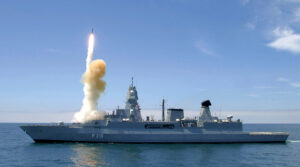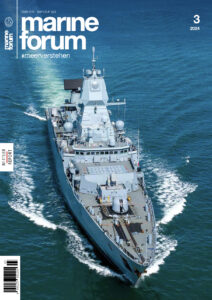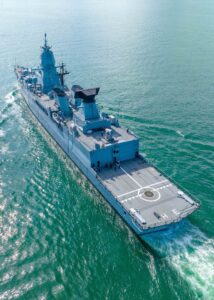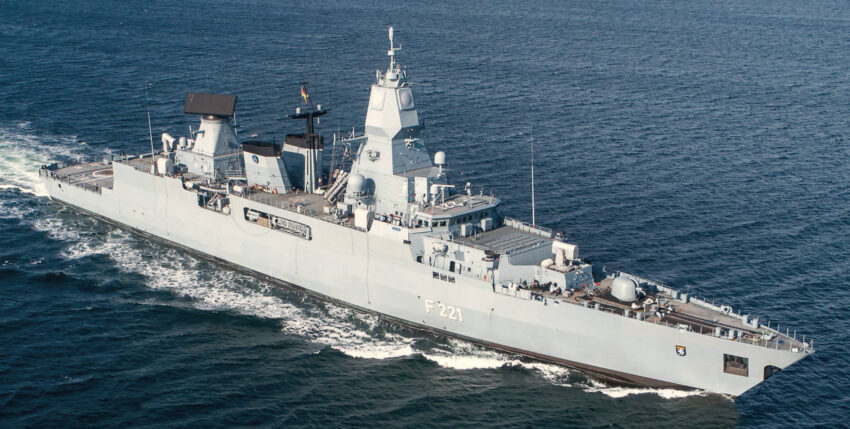Just like the first shots fired by the "Hessians", many a report and many a statement on the subject were also quite off the mark. The difference is that the "Hessen" is drawing conclusions from this. And the leadership is facing it. We are trying to clarify the events as far as we can and want to know....
The frigate "Hessen" moved from its base on Crete through the Suez Canal into the Red Sea immediately after receiving a parliamentary mandate to assemble the contingent for the EU Operation Aspides. There it was approached by UAV shortly after arriving in the area. Not everything went as planned during the operation.
Major mishaps are usually heralded by a bloodcurdling and terrifyingly ugly noise! Not in this case: on the night of 25 February 2024, the "Hessen" used its long-range missiles to combat an unknown, unidentifiable flying object that was obviously not part of the allied scenario - and nothing happened. No explosion, no fireworks - the thing just flew on.
Perhaps it was just as well, because it was an MQ-9 Reaper reconnaissance drone controlled from US CENTCOM in Bahrain - unregistered and with its IFF transponder switched off. How could all this happen?
The following passage from a parliamentary briefing of the past few days provides factual clarification and sober answers - not exhaustive, but certainly satisfying the media's hunger for sensationalism:
"On 24 February 2014, the frigate HESSEN detected a suspicious unmanned aerial vehicle (UAV). As the call procedure for identification was unsuccessful, the HESSEN informed ships and aircraft of allied partners in the area about the UAV and initiated defence measures on the basis of the Rules of Engagement. The missiles fired could not be brought to bear, so that the UAV, which was subsequently assigned to an allied partner nation, was not engaged. This was due to a technical error in a radar system on board the frigate HESSEN. The error was quickly identified and could be rectified immediately. There are therefore no deficits in the chain of command of the weapon system used."
So much for the incident, which shows all parties that when switching from peacetime operations with practice firing and also live firing at a tame target to real combat and actual life-threatening situations, some things have to be learnt and experienced first, because the technical-physical and human-psychological situation is fundamentally different. Nevertheless, the first hurdle has been overcome and has led to clear learning effects on board, in the navy and also in the US services involved.

The class 124 frigate
The "Hessen" is a class 124 anti-aircraft frigate designed for air defence and convoy protection. However, it can also do much more and also has helicopters on board. It was expensive, very expensive - but its military capabilities were so good that the US Navy requested Sachsen-class ships for the air defence umbrella of the Gerald R. Ford carrier group, integrated them into its strike group and even certified them. This ship could also be used to combat intercontinental missiles if the additional investment was made. The German Navy only has three of them, "Sachsen", "Hamburg" and "Hessen". Not only does it have more than other nations, it also has a capacity that is the envy of other navies.
The first time . .
She is one of the best we have in our inventory - fully equipped, ammunitioned and at the highest possible level of training. What the ship and crew lack is war experience. Up to now, the German Navy has mostly only had to utilise the ships' capabilities in less demanding and threatening situations. There have been missions against pirates, embargoes, aid for boat refugees and presence operations - not always without danger, but never real war. Integrated into the carrier group, the "Hessen" (see marine forum Issue 1-2/24), but missiles were always fired under laboratory conditions, in good weather and well prepared, because missiles are incredibly expensive.
. . . it still hurts
Never before in the history of the German Navy has such an unpredictably equipped enemy as the Houthi militias fired a live shot at a naval vessel with the intention of killing Germans. And in the very first real live firing - ad hoc, in a foreign environment with unknown partners - they only hit the target on the "second" attempt, so to speak. What one person might consider embarrassing and absolutely impossible turned out to be an absolutely favourable coincidence - in hindsight, as we now know. Could it all have been avoided? Perhaps. If we had practised can? No - we're going round in circles! No problem, everyone is safe and sound, the crew have done their job well.
Education
It has now been proven that during the years of "low-end" missions, the navy fiercely resisted cutting back on expensive high-end training - both at home and at the Royal Navy in Plymouth. They always wanted to maintain the "high-end" capability, because that's what the ships were built for. Hunting pirates with these ships are the famous pearls in the pigsty. But the Admiralty had managed to get its way - fortunately, otherwise the "Hessians" would not have been allowed to be sent now. And Europe without German participation would have been embarrassing indeed. The navy has kept its promise held.
Ammunition
And now to the debate about ammunition: of course there are too few, everyone knows that, because the Minister of Defence and the Inspector of the Navy have repeated it like a mantra. No one can deny the problem, as the war in Ukraine shows us every day. Nevertheless, the "Hessen" was sent because its magazines are filled to the brim. And not only first-person shooters understand that ammunition runs out at some point. There are reasons why we have too little overall: Until now, everything was more important than buying missiles. We were in Afghanistan, in Mali and in many other smaller missions. First there was a financial crisis, the Bundeswehr was reorganised, then there were refugees. There was enough money for the ships that had been promised to NATO, but there were savings on ammunition. How much was actually bought can be read in the Griephan letters, which every military expert knows. The inspector is constantly putting pressure on us, but he has not yet received the missiles he ordered. Perhaps he will now be listened to when the 124s come home empty - hopefully unscathed.
What else we know and can clarify

To the wide-range sensor
The SMART-L long-range sensor obviously fulfilled its function quite well, otherwise the "Hessen" would not have detected a distant US drone at all. Here, too, the ship did everything right: a target was recognised without friend or foe detection (IFF) - the query to the coalition partners in the US-led Operation Prosperity Guardian and within its own EU coalition Aspides remained without result- in this respect: Control decision.
Since it was - as was later established - a US drone, either the US agency in question did not have a clear picture of the situation (this also happens), or it was not supposed to have a picture because the drone was flying for "another agency". A small hint: US ships share in certain types of operations your LINK situation picture NOT with allies of the "second tier" ("Non" 5-Eyes, FVEY = post-war intelligence agreement AUS, CAN, NZL, UK and US).
For unsuccessful control
The target was not one of those for which an SM-2 mission (Raytheon Standard Missile, range up to 100 nautical miles (170 kilometres)) was originally designed, namely supersonic bombers such as "Backfire" and substantial missiles on a direct approach. In this case, the target flew "slowly" at less than 500 kilometres per hour. In addition, it did not fly directly towards the ship, but passed right by it. However, this reduces the probability of a hit the further away the target is - a physical fact known as the cross-range problem, which all defence missiles have to contend with! An error in the fire control solution was found and rectified very quickly using an internally coordinated naval approach.
The problem of age
The functional chain of the SMART-L long-range sensor / APAR fire control system / CDS F124 weapon deployment system / SM-2 missile is state of the art from the late 1990s. Obsolescence has already occurred here with the entry into service from 2005 and has increased over the last almost 20 years. Against this background, the navy and especially the crew are doing an outstanding job.
To eliminate obsolescence
Corresponding naval initiatives from 2006 were rejected with the 2011 Bundeswehr reform and resubmitted in 2013. According to the Functional Capability Requirement (FFF) ObsWuF LV F124, most of these obsolescences should have been eliminated by 2019. However, prioritisation elsewhere due to a lack of funding has delayed this project, as have wrong decisions regardingsolution overall. In 2021, a contract was concluded with the company Hensoldt, which provided for an Israeli long-range radar to replace the Dutch SMART-L. However, integrating this into the Dutch AAW (air defence) system proved to be a "hproved to be "challenging". So complex that we are currently not looking at a partial start to realisation until 2027, which will inevitably have a negative impact on most other obsolescences.
It's a bit like trying to integrate an APPLE watch into an ANDROID system using a HUAWEI chip, while technical support is gradually being discontinued.
The marine forum reported on several occasions, including in print issues 10 and 11 of 2015 and most recently on marineforum.online in November 2020.
The initial situation
Operationally, the scenario for the "Hessians" does not exactly look "rosy" either:
- Operation Prosperity Guardian is being led by US CENTCOM via Task Force 153 from Bahrain and includes the Eisenhower Carrier Group and a whole handful of Arleigh Burke destroyers, which come under fire almost daily in the southern part of the Red Sea and in the Gulf of Aden and are able to weather it because they are well equipped to do so. Almost a dozen countries are supporting this operation, some of them with naval units, such as the British destroyer "Diamond", which has since withdrawn and stopped for repairs in Gibraltar, or the Danish frigate "Iver Huitfeldt":
- France, Spain and Italy lead their units in the area purely nationally from the respective capitals;
- and as far as EUNAVFOR Operation Aspides is concerned, the Italian frigate "Federico Martinengo" of the Carlo Bergamini-class was replaced by the Horizon-class frigate "Caio Duilio" at the beginning of March in its national role of "maritime surveillance in the Red Sea". Italy had indicated the latter as the lead ship with the force headquarters embarked on board under Italian Rear Admiral Stefano Costatino; however, the parliament in Rome will not be presented with the decision on the mandate until 5 March.

As long as this is the case, active coordination or stringent EU leadership in the area cannot be assumed, even if the superordinate operations headquarters provided by Greece in Larissa has already been set up! And it has now become all too clear that multinational situation management is not so easy to establish.
What came after that
After the first incident, the "Hessen" managed to fend off two drones approaching directly from the Yemeni coast on the evening of 26 February: First, the ship had detected an unmanned aerial vehicle on its radar and probably engaged it shortly afterwards with the Evolved Seasparrow Missile ESSM, which had a range of up to 30 nautical miles (55 kilometres) - with the same negative result as the previous day - and then shot down the drone with the 76mm onboard gun. 15 minutes Later, another drone was detected approaching, against which the short-range defence system RAM (Rolling Airframe Missile) was deployed and destroyed the unmanned system. The successful use of both weapon systems, which are intended for close range of a few kilometres, indicates that the drones had come relatively close to the German ship. So it works at close range - and the fire control algorithms valid for the SM-2 and ESSM have been adapted for further distances. "That should work now!" as the chief engineer on board U96 soberly reported to the commander in the film "Das Boot".
Summarising
So a US drone was shot at. And system routines were verified and corrected that had never been required before. Yes - a lesson was learnt. And no - no human lives were lost!
Instead of showing some understanding for the extraordinarily complex scenario, media representatives in Germany first speculated and then proclaimed guilt and failure. One thing is certain: soldiers - both German and American - do not always do everything perfectly under threat and at risk to their lives. And why should the "Hessians" therefore be a "laughing stock", as the STERN snootily writes? Is an air-conditioned and ergonomically optimised writer demanding unrestricted perfection of action from fighters on the front line without ever having been on a warship with helmet, splinter protection, flame bonnet and nerves strained to the limit? What the "Hessen" doesn't need now are excited know-it-alls from back home. And now a CDU MP of all people has to denounce the lack of ammunition, when he has known about the problem for a long time - and could have campaigned for a remedy much earlier.
Mr Wagner from BILD, on the other hand, was well-disposed and, in contrast to other colleagues, rejected any denigration of German citizens in the war effort. German servicemen and women are deployed to fight for our security and our values. They live from the support and respect they receive at home in their own country. It does something to a person who is involved in a dangerous mission far from home, but has to read ridicule and malice about himself and his service. A war-ready society stands behind its soldiers! Let's start with that.
Just as the Inspector General of the German Armed Forces did, who did not miss the opportunity to be flown on board and support the crew in the Red Sea. This is how leadership works!
Editors: Hans-Uwe Mergener, Axel Stephenson, Holger Schlüter









30 responses
Thank you for this great article.
Fair winds to the crew and thank you for your service to our country.
First of all, thank you for the informative and understandable report.
I absolutely agree with the above comments.
It is a disgrace that our soldiers risk their lives in the worst-case scenario for those who are now running their mouths about them.
I am proud of the girls and boys from Hesse and wish them continued success on their mission and that they can soon return safely to their home harbour.
Bravo Zulu for the report in the Marine-Forum and for the "Hessen"-Crew !
Thank you very much for the objective reporting. I have a relative on board!
One of the best articles I know. Thanks to the team and thanks to the crew of the HESSEN!
Thank you for the crew of the Hessen and this article. It was excellent.
It is a pity that the article is not read by the general public. As a former marine I can understand the problem. In 4 years we were only allowed to fire 4 reusable torpedoes for cost reasons. Nobody is perfect without practice. It's pathetic to mock those who have to cover their arse for us.
Dear Mr Belo (or whatever) - you make the public!
Thank you for reading this article. And if you like it, please share it with friends, relatives, neighbours and perhaps even the less marine-friendly people you know. We have already registered hundreds of thousands of readers. On Monday, we will analyse the results and get back to you.
With best regards
Axel Stephenson
Editorial team marineforum
The armament would be better if a Phalanx MK-15 short-range defence system from Raytheon were available, as could be seen recently in the successfully repelled attack on the USS Carney. 24 other nations already have this system. This must finally come!
Dr Voß,
You must not have read the detailed article carefully! A (further) short-range tube weapon system would have achieved nothing in this scenario.
Gunter Scholz
Mr Scholz,
logically not in addition, but instead!
Dr Voß,
What is logical for you? Is the 20 mm ammunition supposed to be more effective than the 27 mm or 76 mm calibre?
Or are you a lobbyist?
Gunter Scholz
The fact that not everything the US Navy has in use is state of the art can be clearly seen in the RAM/Phalanx comparison. The Americans themselves see RAM as the better alternative to the Phalanx and have started to replace it with the SeaRAM system. Other navies are following the same path (Japan, Great Britain). This system is a smaller RAM launcher that can be built spatially on the existing Phalanx foundations. While the launcher used in the German Navy carries 21 missiles, SeaRAM has only 11, which is considered more effective than the Phalanx. Read more here: https://de.wikipedia.org/wiki/SeaRAM.
Karsten Schneider
Bravo Zulu to Hans-Uwe Mergener, Axel Stephenson and Holger Schlüter for this contribution. Some of the things you read in the media (Frankfurter Rundschau: "German warships do not meet NATO standards") made your toenails roll up.
Good luck to the comrades on board the HESSEN and always a hand's breadth of water under the keel!
Thank you very much for taking a clear stance here and relegating many press releases to where they belong: hearsay, fantasy and crystal ball gossip.
All the best to the "Hessen" and her crew and a happy return home.
Thank you for the good presentation and the appeal to our media. It is sorely needed. All the best and soldierly luck to the crew of the Hessen.
I would like to join you in praising the deployment and the report. As a former "Zwölfender", I also recognise the discrepancy between training and actual deployment. Drawing the right conclusions from the experience gained and incorporating them into training is the order of the day for me. This also includes wishing the crew all the best and a safe return.
Enlightening and interesting info greetings Klaus
Bravo! my thoughts were put into words with this article. this report should be published in all media and I hope that the Hessen team reads this, because these headlines from Stern and Co without any appreciation towards the soldiers were simply disgusting!!!!
Thank you!!!
Thank you for these clear words!
The team from Hesse gives its all to fulfil its mission. They also accept personal restrictions in order to do so. When they left Wilhelmshaven, there were many relatives who are now worried about their loved ones and have to read articles like this.
Simply despicable. This reporter should experience what the team experiences. Then perhaps he would have the necessary respect for their commitment!
That had to be said!
Thank you for this well-founded summary and clarification! Soldiers, including those in the navy, belong in the centre of society. They deserve respect and recognition; because they serve our security!!!
An excellent description of the location. BZ! This report really belongs in all major daily newspapers to counter the many speculations and misinterpretations. All the best to the HESSEN and its crew!
Thank you for the readable and factually informative account of the "HESSEN"'s deployment to date from today's perspective. It is pleasing that, in addition to the technical and tactical description, the crew and their sensitivities in dangerous and combat situations are not neglected.
Thank you for the comprehensive information. Good luck to the crew of the frigate Hessen for their mission and always a hand's breadth of water under the keel.🇩🇪⚓️🇩🇪
Great presentation. Thank you.
Thank you for the very factual explanation of the very complex interrelationships. I won't say anything about our press because I can't say anything factual about it except that I detest the fact that our soldiers who also defend the arse of those who disqualify themselves as worthy of protection through their foolish behaviour and as snipers. I am proud of all my comrades and take a stand in salute.
Excellent summary and clear, not too detailed, clarification of the context of the first and ultimately successful use of weapons by Happy Hessen
Thank you very much for this clarification, which unfortunately has far too little reach. For the sake of politeness, I don't want to comment on our mainstream media - and not just on this topic, by the way. But many fellow citizens (gen. masculine, I don't gender myself) can't be helped anyway. They wallow in German failures, as if they were longing for them in a bizarre romanticisation of doom. And from the term "fit for war" they deduce that Germany is planning a war of aggression against Russia. Crazy!
Thank you for the detailed summary.
Many thanks for this comprehensive presentation!